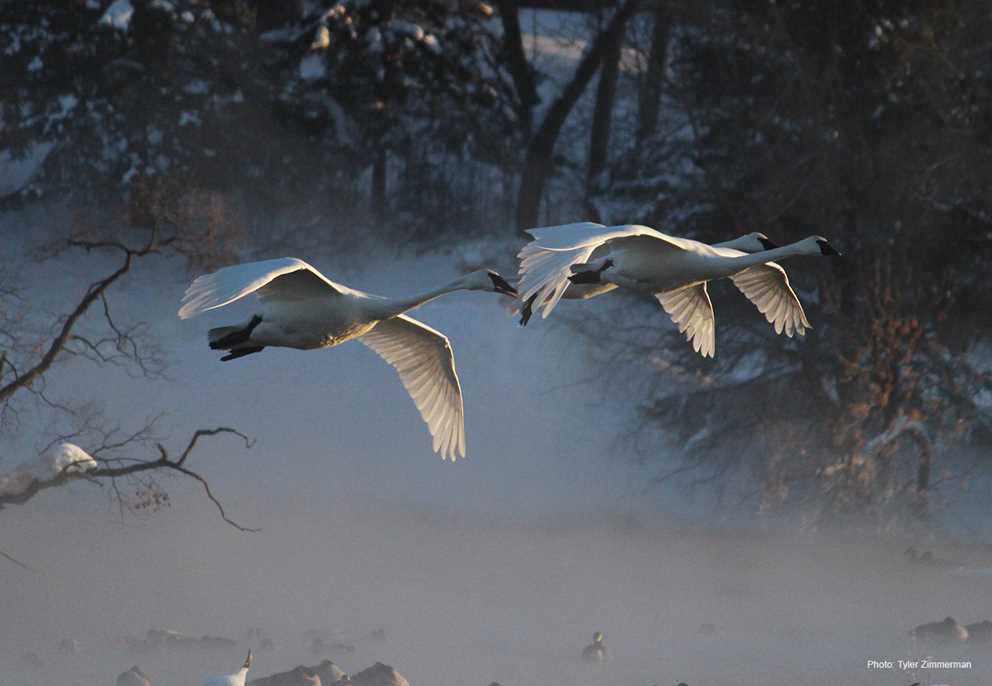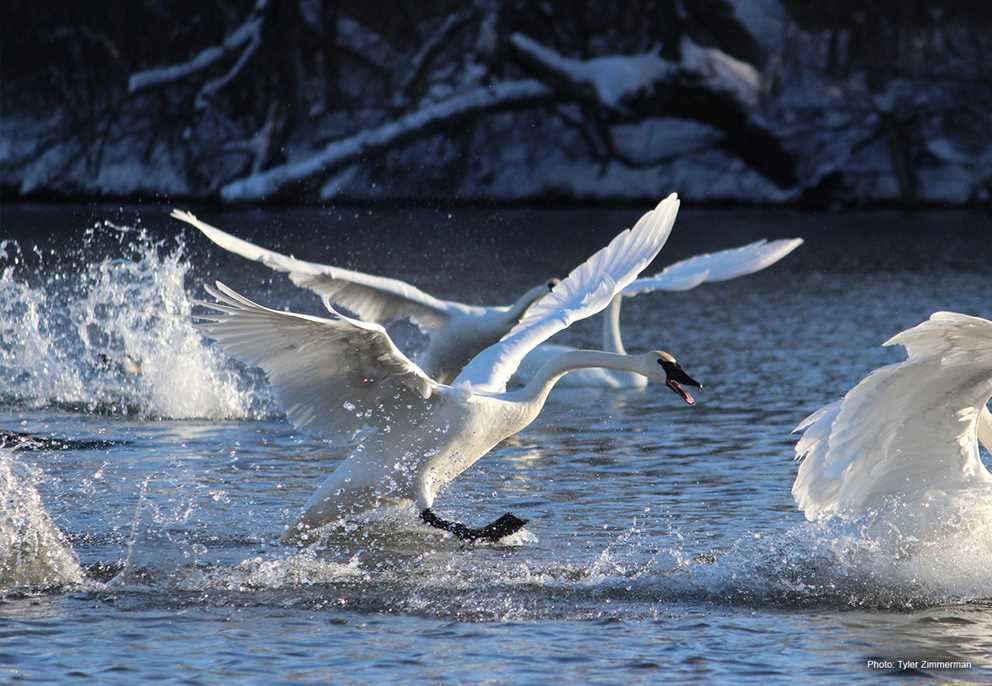Overview
The Trumpeter Swan is endemic to North America and is the largest species of waterfowl in the world. Their population was on the verge of extinction in the early 1900s, and their subsequent population recovery is among the great conservation achievements of the past century. The population was reduced to only 69 birds remaining in remote areas of Yellowstone National Park, but as of 2015, has recovered to at least 63,000 birds across their historical range resulting from conservation efforts by many waterfowl biologists.
There are three populations in North America, the Pacific Coast, Rocky Mountain, and Interior Populations. The Pacific Coast population breeds in Alaska and represents 60% of the continental population. The Interior Population is the result of extensive restoration efforts across the species former range. Adult Trumpeter Swans are large, all white, and the sexes are identical, while immature birds are brownish. While the species’ overall recovery is a conservation success story, there are still significant portions of its historical range where recovery is slow, or yet to occur.
Description
Key Identification Features
- The plumage of adult Trumpeter Swans is white, although the head and neck are sometimes stained orange to rust from foraging in iron-rich wetlands.
- The bill, tarsi, and feet are black, and Trumpeter Swans lack any yellow on the lores.
- The bill is longer and straighter than the similar Tundra Swan, and may show a salmon to orangish streak on the upper mandible.
- Immatures are brownish overall, with pinkish, gray, or sometimes black bill, and the tarsi may be yellowish to pinkish to gray.
Male/Female Average Length and Weight
- Mass: Male 25.1–32.0 lbs.; Female 20.1–22.9 lbs.
- Wing Length: Male 24.4 in.; Female 24.5 in.
Male and Female Identification
- Alternate (Breeding) and Basic Plumage: Both adult plumages of both sexes are identical. White plumage, with straight, long black bills, the black extending to and forming a point at the eye. Feet are black. Immature birds are brownish, with pinkish bills, and gray feet.
In-Flight Identification
- Just before taking off and landing, Trumpeter Swans pull their necks into an S shape.
- Trumpeter Swans are exceptionally large and white.
Vocalizations
- Adults make a trumpet-like “oh-OH,’ and a lower trumpet-like call of “hoo.”
Similar Species
- Tundra Swans: Adults may be easily confused with the Tundra Swan in North America. Compared to Tundra Swans, Trumpeters will have a longer, straighter bill that lacks a yellow lore spot, and the black extending from the bill to the eye is narrower and pointier. Calls also distinguish the two species.
Habitat Preferences
- Trumpeter Swans are typically found in freshwater wetlands, ponds, or lakes, and occasionally small streams and rivers. They prefer wetlands with substantial emergent or floating vegetation upon which they feed. In migration and winter, they use marshes and lakes with abundant vegetation upon which they feed.
Foraging Habits and Diet
- Trumpeter swans are vegetarian with a diet consisting of submerged plant material including tubers, roots, stems, and leaves of various emergent and aquatic plants.
Breeding Habits
- Monogamy: Trumpeter Swans maintain monogamous, lifelong pair bonds. Pairing begins at 20 months and may require a year or more before being fully established. They nest at 4–7 years of age, although some records of nesting at age 2–3 exist.
- Nest Locations: Nest initiation dates vary with latitude and ice conditions, but usually it is May–June. The nest is a large mound of plant material usually on top of emergent vegetation or islands that may take 2–5 weeks to construct.
- Clutch Size: 4 to 6 eggs. The eggs are creamy white to dull white, sub-elliptical to long elliptical, and average 4.5 by 3.0 in. The incubation period is about32 to37 days, with females performing more of the incubation duties than males, but both participate. Males provide nest defense.
Migration & Distribution
- Trumpeter Swans are short distance migrants, and some may not migrate if open water and food remain available. Northernmost populations may make short migrations to areas with open water.

Conservation Status
- IUCN Status: Least Concern
- Population Status: The population is stable to increasing throughout their range, and as of 2015 was estimated at 63,000.
- Conservation Concerns: The primary threats include lead poisoning, climate change, and habitat loss.
- Conservation Focus: Conservation efforts focus on studying the behavior and numbers of swans and reintroducing them to parts of their range from which they are extirpated.
Harvest Information
- Trumpeter Swans are a protected species with no hunting season in North America.




